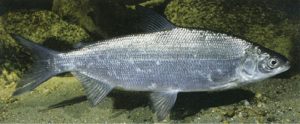Hake (lat. Merluccius) is a genus of fish of the family milosovich, including about ten closely related species. Included in the squad trnkobrani. Hake is also called a Hickey. Common on the continental shelf of the Pacific and Atlantic oceans. In Europe they are recognized as the best representatives among fish cod species.
Depending on the length of the body hake is 30 cm to a meter and a half. This is a fish with an elongated body and a narrow head, and lower jaw much longer than upper. The back is grayish black shades, belly and flanks are lighter, silvery gray.
Hake has a distinctive feature – the black color of the mouth. This is mainly demersal fish rising for food in the upper layers of water. Adults feed on bottom fishes (herring, sardines, cod, mackerel), squid, and also their own offspring. Young fish eat small crustaceans, including euphausiid crustaceans. They reach reproductive maturity to four years. Spawning in many species long, extended into the summer months. Spawning takes place in portions. Sweeps eggs rise to the surface. Larvae first live in the water column, and when you reach the phase of young, then gradually move to the bottom type habitat.
Hake, better known as hake, inhabits the Eastern Atlantic, off the coast of Iceland and Norway, found in the Mediterranean sea at depths from 150 to 400 m. In our country it comes across in the southeastern part of the Black sea. Average fish length – 40 cm, however, there are huge specimens of size up to one meter and weight up to 10 kg. for the industrial stocks in European waters are formed during the spawning season. Catch this kind of hake off the coast of Scotland, Ireland, Portugal and the Bay of Biscay. European hake meat is especially appreciated in Spain. Off the coast of North America at depths from 50 m to 900 m distributed silver hake. Many from Newfoundland to South Carolina. Reaches a length of about 70 cm and weight up to 2.3 kg.
Winters on the continental slope and pre-spawning period in the spring, leaves in the shallows of the shelf. Catch of silver hake off the coast of Nova Scotia. The largest catches of this species hake produces the United States and Canada. Another major view of Pacific (Oregon) hake inhabits the northeast Pacific from Vancouver island to Gulf of California. Sometimes it comes across in the Southeast Bering sea. The average length of 50-55 cm individuals Making migration for spawning is about 1000 km.


This is the most numerous fish throughout the California current system, but the number varies greatly depending on the fertility of individual generations. Prior to 1966 this species had almost no economic value, and in the early 70-ies was discovered, its mass accumulation and she has gained commercial status. Currently, the catch of Pacific hake is great, and a leader in her catch of the United States. Also, species of this family are considered to be Argentine, Chilean, new Zealand and Cape hake.
Hake meat is white and juicy, fairly lean, malacolite. It is in high demand in all European restaurants. For example, the French stewed the fish in white wine or beer, cooked him omelets. Hake is recommended for freezing because fresh she tends to quickly lose its taste and aroma. This problem helps to avoid a quick freeze. Of hake prepare delicious cold appetizers, first and second dishes as well as fish-flour products.
Fish is good boiled or roasted, as well as for cooking cutlets, meatballs, puddings. For greater caloric hake cooked with sauces of sour cream, butter and cream. To the meat of hake are great variety of seasonings: white pepper, nutmeg, allspice, dry sweet paprika, ground coriander seeds, thyme, fennel, green onions, celery, garlic.


